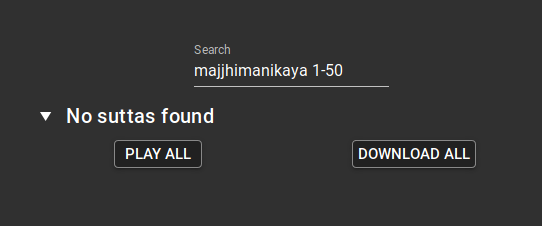Oh, that ‘voice’ page is helpful! I also found it very hard to search Suttacentral initially. And in fact I still do when I haven’t been to the site for a while and forget its idiosynchrasies. I would like to ask, why is the main site not made to function the same way with regards to searching as this ‘voice’ page?
I believe it’s very counterintuitive to need to type in the text abbreviation into the URL part of the page. Firstly because that’s not at all the standard way to search any normal site. Secondly because the user has to be familiar with exactly what and how to write in the URL space.
May I suggest that the search function be improved? I think this point of view is backed up by the fact that this thread has been made at all - as the OP pointed out, people can be at a loss of how even to recommend their friends to navigate this wonderful website! And they point to the same issue I had, attempting to search and then ending up trying to dive through the navigation system on the left. I’ve done so much searching and reading through the canon, but I still get stuck especially with the KN, trying to remember which division and subdivision to find the text in that I’m looking for.
So may I suggest having the the search function changed?
For example, if I search that ‘voice’ page for ‘MN 73’, I get one result, MN 73! Perfect! Just as any random reader on the internet would expect it to work, and get the result which almost everybody will want when searching ‘MN 73’!
But the main site? Searching ‘MN 73’ gives the following 8 results, in this order:
MN 42
MN 132
Thag 16.8
Thag 16.6
MN 134
Thag 20.1
Thag 16.4
MN 125
So, the ‘voice’ page gives one result, the right one. And Suttacentral gives 8 results, all the wrong ones. But, the voice page still requires work to get to the actual sutta - first you’re presented with 4 different things to click (at this point I went wrong, ended up nearly downloading a file, eventually the page went completely black and I started again from scratch to see if I could get it right with another try). If you do click the right button, you’re given 5 more options, and this is where you can find the link to the sutta - a total of 3 clicks after getting the search results.
If Suttacentral would have the same search function as that voice page, and give the correct result straight off the bat, it would be clickable right away. I think that’s what people want and what they expect - do a search, get the right answer, and in one click, get to where they want. That’s intuitive.
And if that type of search is seen as being too limiting, may I recommend the option of ‘search title only’, vs. ‘search title and contents’ or something like that. That’s a pretty standard type of option found on so many websites, especially forums, and so people will find it very familiar, and I believe it would be very functional. Other common options might be things like ‘exact match’ or ‘search phrase’ or whatever. On many websites these and/or other search options will be given through an ‘advanced search’ function that’s usually accessible via a button right next to the standard search function.
Another very common function that people would generally find intuitive is to be able to search “MN 73”, using quote marks, in order to force a search function to search for the exact match. On Suttacentral this also doesn’t work. It still produces the same 8 false matches as when you leave out the quote marks.
I really think that the search function is essential. There are so many wonderful translations on the site! But people cannot read them if they can’t find them, and I feel quite sure that many many people will be using the search function in normal ways in order to look up suttas. Since that doesn’t work, and you need to know very unusual ways (even if clever and efficient once you have learned them), many people will simply give up after the search function fails, as it has here with my first random search, ‘MN 73’. And they might never come back to the site again!
So if it’s at all possible, I think this would really make a very significant difference indeed. Many more visitors to the site will end up reading the texts they’ve come here to search for, and many of those will return again and again now that they’ve discovered a place they can actually find the texts.





